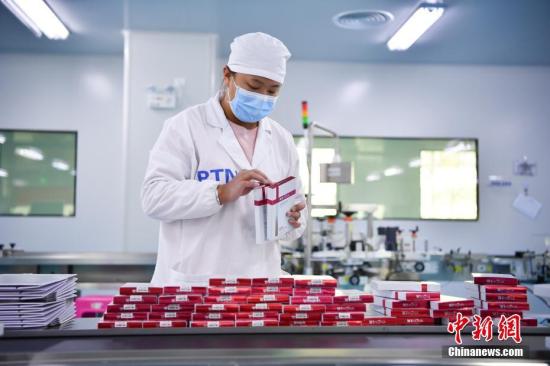(Countering new crown pneumonia) China's economic war "epidemic" record: division and grading, accurate resumption of work and resumption of production, lowering emergency response levels in many places
China News Agency, Beijing, February 26 (Xia Bin) One hand grasps the fight against the "epidemic", and the other hand resumes production, and China "adjusts to local conditions." Neither can we adopt a "one-size-fits-all" approach to different regions and hinder the restoration of economic and social order, nor can we relax prevention and control and cause our previous achievements to be abandoned. The central government proposed to implement the division and grading of precise resumption of work and production. Low-risk areas should adjust their prevention and control strategies to external defense inputs as soon as possible to fully restore production and living order. Middle-risk areas should resume work and production in an orderly manner based on the prevention and control situation. High-risk areas should continue to focus their efforts on epidemic prevention and control.
Liu Shijin, deputy director of the China Development Research Foundation, bluntly stated that in order to formulate and implement policies based on actual conditions, we must be both responsible and capable. Different situations and policies in different regions will restore production and economic recovery under the premise that the epidemic can be controlled.
"The epidemic prevention and control has indeed achieved some results so far, but it should still be emphasized that there is no paralysis and fluke mentality, and the achievement is the basis for promoting the differentiation and control of zoning and differentiation." Said Zhang Yu, chief macro analyst of Huachuang Securities.
On February 26, workers at Honglong Company in Wubaihu Town, Xianghe County, Langfang City, Hebei Province are using machine tools to produce frames. Hebei Province adheres to precise policy, implements differentiated prevention and control strategies according to risk levels, and organizes enterprises to resume work and production in an orderly manner. Photo by China News Agency reporter Song Mintao
Data show that as of 24:00 on February 25, more than 1,000 people have been cured and discharged from hospitals across the country for 14 consecutive days; new confirmed cases have been maintained for several consecutive days at zero.
Cong Liang, Secretary-General of the National Development and Reform Commission of China, told reporters from the China News Agency: "Each province, region, and city is determining the low, medium, and high risk based on the (local) epidemic situation, and how to resume work based on different risks. The specific risk determination and resumption of production are determined by the local government. Take it for yourself. "
According to the China News Agency reporter's previous review of the resumption rates of industrial enterprises above designated size in various provinces, autonomous regions and municipalities, it can be seen that in areas with relatively severe epidemics, the rate of return to work is slightly lower, while in areas with relatively light epidemics, the rate of return to work is generally higher.
The central government pointed out that as the situation of epidemic prevention and control continues to improve, eligible provinces should reduce their response levels and implement dynamic adjustments in a timely manner.
At present, according to relevant regulations and the situation of epidemic prevention and control of new crown pneumonia in various places, the emergency response levels of new crown pneumonia have been adjusted.
On February 25th, employees in the Winona skincare production workshop in Kunming, Yunnan, worked on the production line. With the implementation of policies and measures in Yunnan to reduce the costs of physical enterprises, increase assistance to enterprises to stabilize their posts, protect supplies for epidemic prevention and control, and increase financial support, enterprises in this province are orderly resuming production. Photo by China News Agency reporter Liu Ranyang
Jia Jinjing, assistant dean of the Chongyang Institute of Finance of Renmin University of China, told the China News Agency that adjusting response levels means that localities can flexibly and timely adjust their priorities according to their own conditions, which can not only ensure continuous prevention and control measures, but also resume work and resume production.
Chang Wei Securities chief macro analyst Zhao Wei believes that under the guidance of "differentiated prevention and control strategies", the restoration of production and demand will be gradually realized instead of overnight, and complete restoration or time will still be required. This is based on epidemic development and policy adjustments. And gradually realized.
The resumption rate of industrial enterprises above designated size is gradually increasing. As of February 24, Zhejiang has exceeded 90%, and Jiangsu, Shandong, Fujian, Liaoning, Guangdong, and Jiangxi have exceeded 70%. According to the monitoring, small and medium-sized enterprises have also started construction. Start-up has gradually picked up, and the start-up rate has approached 30%.
According to Alipay data, 39% of the first batch of return-to-work shops monitored by it have restored their single-day flow to the daily level before the Spring Festival and successfully achieved "blood back".
Cheng Shi, chief economist of ICBC International, believes that under the “new steady state” of resumption of work, the focus of policy is expected to shift to structural tools in the non-financial field. Two measures are worth looking forward to.
First, improve logistics efficiency by adapting to local conditions. In epidemic-stricken areas, unnecessary logistical obstacles should be eliminated on the premise of strengthening epidemic prevention monitoring at the starting point and end point; in key epidemic-stricken areas, targeted logistics subsidies will be provided to restore the basic economic cycle.
Secondly, the "dilemma" between migrant workers and SMEs should be broken. Small and medium-sized enterprises are the main force for absorbing migrant workers' employment. Local governments are expected to strengthen policy guidance, material support, and policy coordination in the inflow and outflow of migrant workers, and complete the matching of labor supply and demand for migrant workers and SMEs in batches. (Finish)

